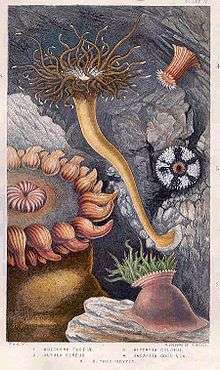Bolocera tuediae
| Bolocera tuediae | |
|---|---|
 | |
| Deeplet sea anemone | |
| Scientific classification | |
| Kingdom: | Animalia |
| Phylum: | Cnidaria |
| Class: | Anthozoa |
| Order: | Actiniaria |
| Family: | Actiniidae |
| Genus: | Bolocera |
| Species: | B. tuediae |
| Binomial name | |
| Bolocera tuediae Johnston, 1832[1] | |
| Synonyms | |
|
List
| |
Bolocera tuediae, commonly known as the deeplet sea anemone, is one of the largest North Sea anemones. It can grow up to 300 millimetres (12 in) across the tentacles. It has been recorded from all coasts of Britain, but is more rare in the south. Recent records from divers are in Scottish sea lochs. It is generally distributed throughout the northern Atlantic Ocean to the Arctic Circle and east to North America.
Characteristics
Its body is very smooth and is usually pink or red colored. Its tentacles are long, stout and graceful in full expansion. It is capable of shedding its tentacles, pinching off by muscular action. The body is often serves as protection for other animals, like the deepsea king crab (Lithodes maja).
Habitat
This anemone is found in sheltered habitats attached to rocks, stones, shells, corals, and any other hard surface object in the ocean. It can be found from about 20 metres (66 ft) to more than 2,000 metres (6,600 ft) deep.
References
- ↑ Bolocera tuediae Johnston, 1832. Retrieved through: World Register of Marine Species.